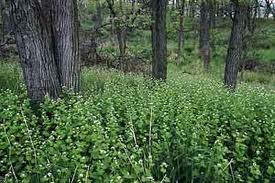 |
| photo from the internet |
 |
| photo from the internet |
- Garlic mustard is a member of the mustard family. It has a long thin white tap root with a bit of a crook just below the soil level. It can be self-pollinating or pollinated by insects. It has accustomed itself to North America quite well, grows as an understory plant in forested areas and out in the open. Becoming more common in the eastern United States. It is a competitive weed, producing a toxin which prohibits the development of mycorrhizal fungi, a fungus which aids in the growth and development of plants and trees.
- Garlic mustard seed is viable for five years! It is shade tolerant but has been found growing in full sun as well. It prefers a rich and moist soil that is more alkaline than acidic.
- Intense tillage has shown to be somewhat effective in curtailing its growth. A thick mulch of wood chips has been known for effectiveness. Hand pulling is effective providing the majority of the root, if not all, is removed intact. Mowing can help prevent seed production if mowed low to the ground and repeated regularly throughout the season.
- Some chemicals have proven effective in eradicating garlic mustard including spot applications of glyphosate and triclopyr when used on young plants. Contact a local Certified Pesticide Applicator or an Agricultural Fieldman for chemical control and more information.
 |
| photo from the internet |
I've written of other prohibited and noxious weeds. See Giant Hogweed , Toadflax and Himalayan Balsam
For more information visit the province's site listed below.
http://www.invasiveplants.ab.ca/.
http://www.invasiveplants.ab.ca./Downloads/FS-GarlicMustard.pdf
1 comment:
Vicki one of my blog friends was trying to get rid of it when she had moved to a new house. I am going to take a good look next season....
Post a Comment